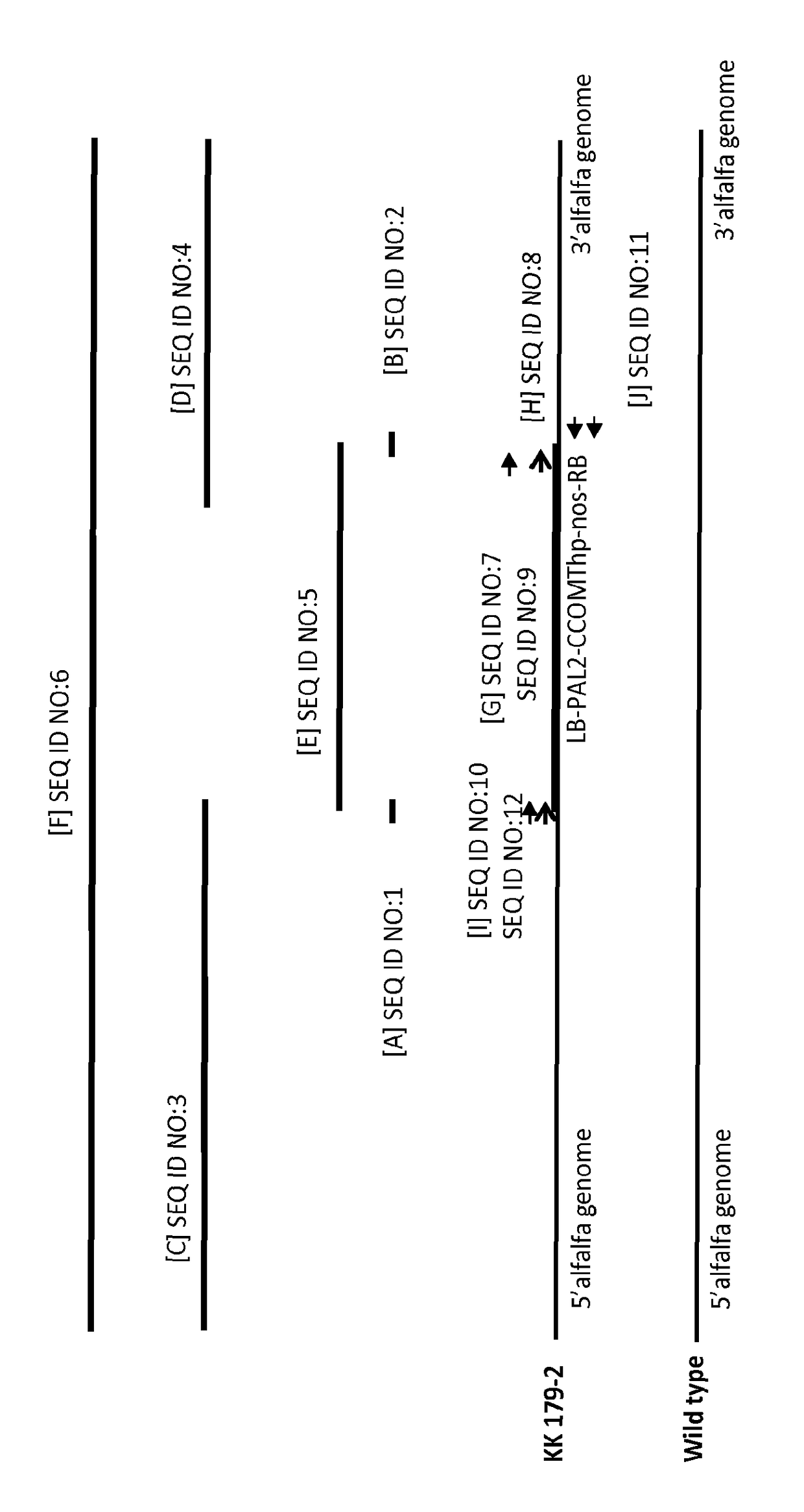Alfalfa plant and seed corresponding to transgenic event KK 179-2 and methods for detection thereof
a technology of transgenic events and alfalfa, applied in the field of alfalfa transgenic events kk1792, can solve the problems that methods may not be useful in discriminating between different transformation events, and achieve the effect of reducing lignin conten
- Summary
- Abstract
- Description
- Claims
- Application Information
AI Technical Summary
Benefits of technology
Problems solved by technology
Method used
Image
Examples
example 1
of Flanking Sequences Using Inverse PCR and Identification of Flanking Sequences by Sequencing
[0085]This example describes isolation of the alfalfa genomic DNA sequences flanking the transgenic DNA insert using inverse PCR for event KK179-2, and identification of the flanking genomic sequences by sequencing.
[0086]Sequences flanking the T-DNA insertion in event KK179-2 were determined using inverse PCR as described in Ochman et al., 1990 (PCR Protocols: A guide to Methods and Applications, Academic Press, Inc.). Plant genomic DNA was isolated from both wild-type R2336 and the transgenic line from tissue grown under greenhouse conditions. Frozen leaf tissue was ground with a mortar and a pestle in liquid nitrogen or by mechanical grinding, followed by DNA extraction using methods known in the art. This method can be modified by one skilled in the art to extract DNA from any tissue, including, but not limited to seed.
[0087]An aliquot of DNA from each sample was digested with restrictio...
example 2
cific Endpoint TAQMAN®
[0091]This example describes an event-specific endpoint TAQMAN® thermal amplification method for identification of event KK179-2 DNA in a sample.
[0092]Examples of conditions useful with the event KK179-2-specific endpoint TAQMAN® method are described in Table 2 and Table 3. The DNA primers used in the endpoint assay are primers SQ20901 (SEQ ID NO: 7) and SQ23728 (SEQ ID NO: 8) and 6-FAM™ labeled oligonucleotide probe PB10164 (SEQ ID NO: 9). 6FAM™ is a fluorescent dye product of Applied Biosystems (Foster City, Calif.) attached to the DNA probe. For TAQMAN® MGB (Minor Groove Binding) probes, the 5′ exonuclease activity of Taq DNA polymerase cleaves the probe from the 5′-end, between the fluorophore and quencher. When hybridized to the target DNA strand, quencher and fluorophore are separated enough to produce a fluorescent signal.
[0093]Primers SQ20901 (SEQ ID NO: 7) and SQ23728 (SEQ ID NO: 8) when used as described with probe PB10164 (SEQ ID NO: 9) produce an am...
example 3
Example 3: ADL Measurements in the Lower Stem of Reduced Lignin Alfalfa Events
[0099]
TABLE 4Lower stem ADL measurements for the 6 reduced lignin alfalfaevents in two fall dormant (FD) germplasms from 3 locationsin 2008.DeltaDeltaDormancyEventLCI @UCI @P-EventgermplasmMeanDelta90%90%% Diff.valueJJ041FD7.91−1.75−1.97−1.52−18.09JJ266FD7.48−2.18−2.39−1.98−22.60KK136FD7.01−2.64−2.90−2.39−27.40KK179FD7.65−2.01−2.24−1.79−20.83KK376FD7.37−2.29−2.55−2.04−23.75KK465FD7.30−2.36−2.59−2.13−24.44JJ041FD7.71−1.77−2.01−1.53−18.70JJ266FD6.98−2.50−2.74−2.26−26.38KK136FD7.38−2.10−2.34−1.86−22.14KK179FD7.56−1.92−2.16−1.68−20.24KK376FD6.51−2.97−3.21−2.73−31.33KK465FD7.33−2.15−2.39−1.91−22.68Abbreviations used in the tables that follow:ADL = Acid Detergent Lignin, % of dry matterLSD = Least Significant DifferenceFD = Fall DormantKK179 = KK179-2 reduced lignin alfalfa lead eventDelta = difference between Event and Control means (Event − Control)% Diff = Percent difference between Event and Control (Delta / C...
PUM
| Property | Measurement | Unit |
|---|---|---|
| temperature | aaaaa | aaaaa |
| temperature | aaaaa | aaaaa |
| temperature | aaaaa | aaaaa |
Abstract
Description
Claims
Application Information
 Login to View More
Login to View More - R&D
- Intellectual Property
- Life Sciences
- Materials
- Tech Scout
- Unparalleled Data Quality
- Higher Quality Content
- 60% Fewer Hallucinations
Browse by: Latest US Patents, China's latest patents, Technical Efficacy Thesaurus, Application Domain, Technology Topic, Popular Technical Reports.
© 2025 PatSnap. All rights reserved.Legal|Privacy policy|Modern Slavery Act Transparency Statement|Sitemap|About US| Contact US: help@patsnap.com

